Don’t you hate it when you’re in the middle of baking a cake and find out you don’t have a specific ingredient? Well you don’t have to just give up. This post is all about cake baking substitutions plus there’s a free printable reference guide.
So, I have done this myself countless times and wished I had an easy ‘cheat sheet’ I could pull out with substitutions. I figured I can’t be the only one, so I wanted to pull everything together in one place to give you lots of options.
As an Amazon Associate, I earn from qualifying purchases.
Now before we get too far into the substitutions, I need to point out a few things.
SUPER IMPORTANT: PLEASE NOTE THESE THINGS BEFORE USING SUBSTITUTIONS!
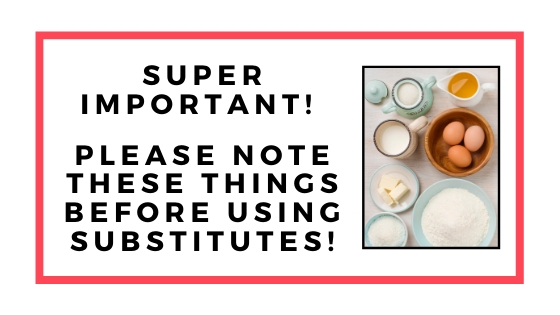
First, ingredients do different things in cakes. The best thing to do is to use the ingredients that the recipe calls for, but if you absolutely cannot, then I’ve listed out a number of substitutes to try.
Now ‘try’ is the operative word here. None of these subs are ideal because it’s not what was called for, so there’s going to be some give and take…especially with the oil and egg substitutes.
Using some of these will change the cake texture. (especially the egg substitutes) Please be aware of that.
Many times food bloggers get bad reviews when ingredients are substituted in our recipes and they don’t come out the same or the results just aren’t what is expected.
Please be aware that the ideal is to use what the recipe calls for and that normally, we (recipe writers and testers) are unable to test out every type of substitution you might need for each recipe we write. (There’s just not enough time in a day to do that.)
Basically, use these substitutions at your discretion and just know that they are fall-backs only when you can’t get the ideal ingredient, or perhaps you have an allergy to what the recipe calls for. Just know you may have to experiment with different options here to get the right texture/taste.
Please also note that I have not tried out every single one of these substitutions. I have tried many, but not all. Even if I had, different substitutions will work differently for each individual recipe. Using substitutions, especially in baking, really is an experiment and trial and error.
Alright, with all that said, let’s get to the list of cake ingredient substitutions. And don’t forget, at the end of the list is a handy printout you can click on and it will automatically download. You can save it to your phone, computer, or print it out for reference.
Ok, let’s get to the list now.
Cake Baking Substitutions:
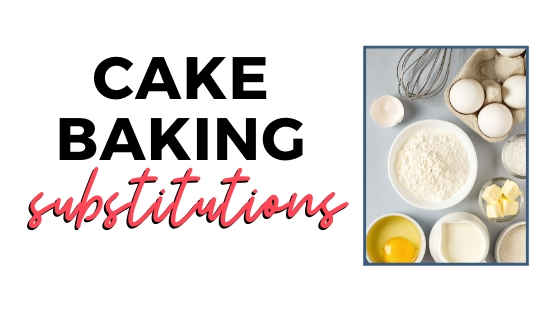
By the way, I’ve tried to organize these substitutes into sections.
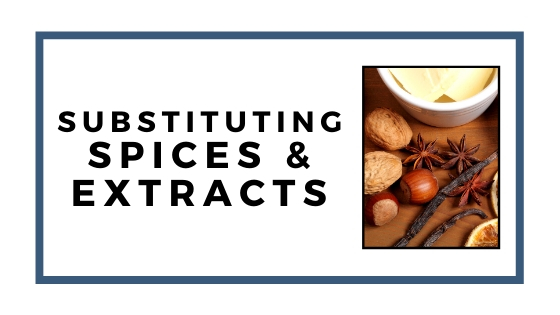
Substituting Spices/Extracts:
- Allspice (1 teaspoon = ½ teaspoon cinnamon, ¼ teaspoon ground cloves, ¼ teaspoon ground nutmeg)
- Pumpkin pie spice (1 teaspoon = 1 teaspoon cinnamon, ¼ teaspoon ground ginger, ⅛ teaspoon ground cloves and ¼ teaspoon ground nutmeg)
- Vanilla extract (3 teaspoon = 1 whole vanilla bean split OR maple syrup in the same amount)
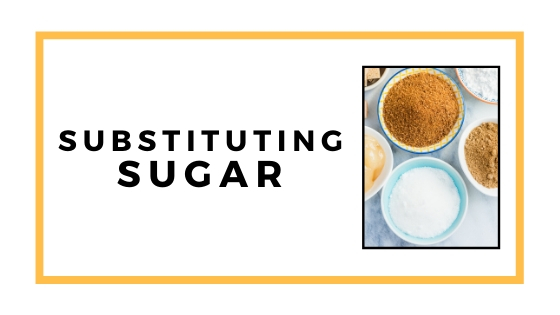
Substituting Sugar:
- Brown sugar (1 cup = for light brown: 1 tablespoon molasses plus 1 cup white granulated sugar or for dark brown: 2 tablespoon molasses plus 1 cup white granulated sugar) Note 1: you can also try using maple syrup if you don’t have the molasses. Note 2: light brown and dark brown sugar can be substituted for each other.
- White granulated sugar (1 cup = 1 cup packed brown sugar)
- Powdered sugar (1 cup = 1 cup granulated sugar in a blender plus 1 teaspoon cornstarch or arrowroot powder)
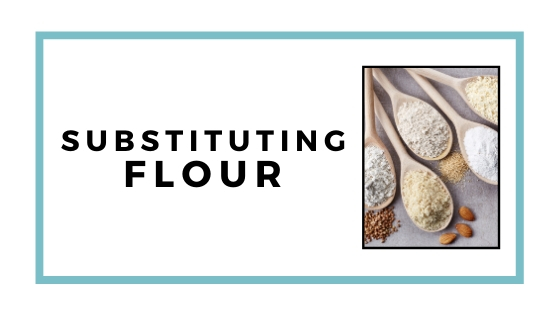
Substituting Flour:
- Cake flour (1 cup = 1 cup of all purpose flour, remove 2 tablespoon of it and replace it with 2 tablespoon cornstarch)
- All purpose flour (1 cup = 1 cup cake flour plus 2 more tablespoons cake flour OR Use self-rising flour and leave out the baking powder and salt from the recipe – use this substitute as long as the recipe calls for about ½-1 teaspoon of baking powder per 1 cup flour. If the recipe calls for more baking powder than ½-1 tsp, you’ll need to add in more baking powder to make up the difference)
- Self rising flour (1 cup = 1 cup all purpose flour plus 1 ½ teaspoon baking powder plus ¼ teaspoon salt)
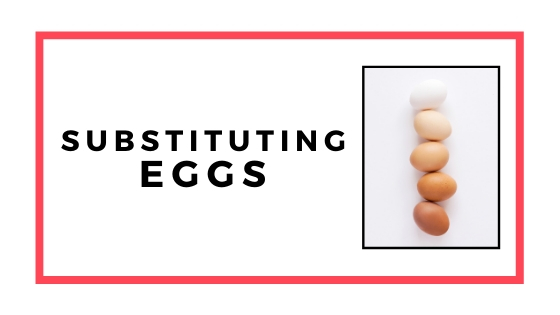
Substituting Eggs:
- Eggs (1 egg = ¼ cup unsweetened applesauce OR ¼ cup mashed banana or pureed fruit OR 1 tbs flaxseed (or chia seeds) mixed with 3 tablespoon hot water until absorbed and thick OR use commercial egg replacer OR ¼ cup silken tofu pureed OR 1 teaspoon baking soda with 1 tablespoon vinegar OR ¼ cup yogurt or buttermilk OR 2 tablespoon arrowroot powder mixed with 3 tablespoon water OR 3 tablespoon liquid from canned beans OR 1 tablespoon soy lecithin)
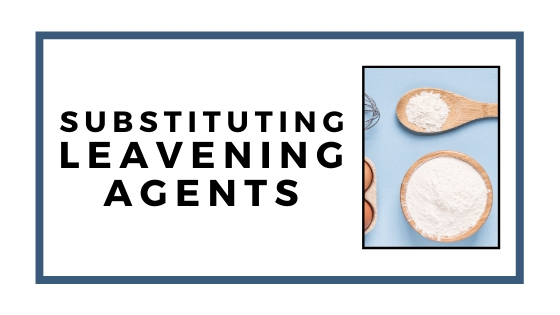
Substituting Leavening Agents:
- Baking powder (1 teaspoon = ½ teaspoon cream of tarter plus ¼ teaspoon baking soda OR ¼ teaspoon baking soda mixed with ½ teaspoon vinegar OR use self-rising flour in place of the flour called for in the recipe-the amount depends-see flour substitute section)
- Baking soda (1 teaspoon = 3 teaspoon baking powder and reduce the salt called for in the recipe by half and perhaps replace acidic ingredients in the recipe with non acidic ones (ie: use regular milk instead of buttermilk OR you can try whipping your egg whites and cream before adding them to your cake batter to incorporate a bit more air to help with the leavening.)
For more info on baking soda and baking powder (why they’re not interchangeable) see this post: Baking soda and Baking Powder: What’s the Difference?
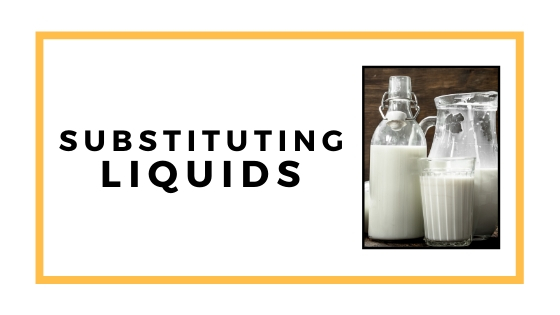
Substituting Liquids:
- Buttermilk (1 cup = 1 tablespoon lemon juice or vinegar plus enough milk to make 1 cup. Let it stand for 5 minutes before adding to cake batter OR 1 ¾ teaspoon cream of tarter plus 1 cup milk. Let stand for 5 minutes before using OR ¾ cup yogurt plus ¼ cup whole milk OR ½ cup sour cream plus ½ cup whole milk)
- Yogurt (1 cup = 1 cup buttermilk OR 1 cup sour cream OR 1 cup cottage cheese blended smooth OR 1 tablespoon lemon juice or vinegar plus enough milk to make 1 cup. Let it stand for 5 minutes before adding to cake batter)
- Sour cream (1 cup = 1 cup full fat yogurt OR ¾ cup sour milk or buttermilk mixed with ⅓ cup melted butter. To make sour milk, or buttermilk, measure one cup of milk and take out a tablespoon of it. Add in a tablespoon of lemon juice or vinegar.)
- Milk (1 cup = canned coconut cream OR ¾ cup sour cream mixed with ½ cup water OR ½ cup evaporated milk mixed with ½ cup water OR 1 cup water mixed with ⅓ cup nonfat dry milk OR ½ cup half and half mixed with ½ cup water OR 1 cup buttermilk mixed with ½ teaspoon baking soda)
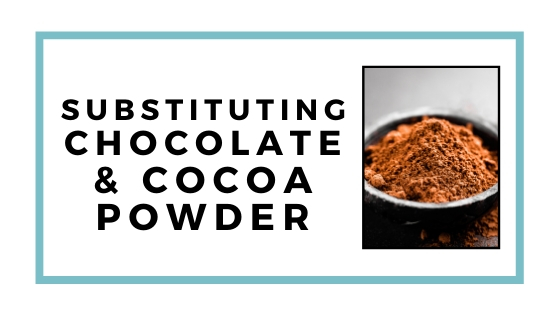
Substituting Chocolate/Cocoa Powder:
First, I do not recommend using regular melted chocolate to substitute for cocoa in a cake recipe. The main reason is because cocoa gives a much stronger flavor to the cake. It’s essentially concentrated, so you are going to get much more of a chocolaty taste using cocoa than melted chocolate.
With that said, if you really have to substitute, feel free to try these out:
- Natural unsweetened cocoa powder (not dutch processed cocoa powder) (3 tablespoon = 1 oz unsweetened baking chocolate (melt and add to the batter) then omit a tablespoon of butter or oil that the recipe calls for OR 3 tablespoon dutch processed cocoa powder plus ½ teaspoon cream of tarter mixed with lemon juice or white vinegar)
- Dutch processed cocoa powder (3 tablespoon = 3 tablespoon natural unsweetened cocoa powder plus ⅛ teaspoon baking soda for every 3 tablespoon cocoa powder that’s called for.)
- Semi-sweet chocolate, melted (1 oz = 1 oz unsweetened baking chocolate melted and mixed with 1 tablespoon granulated sugar OR 3 tablespoon unsweetened cocoa powder plus 3 tablespoon sugar plus 1 tablespoon butter or shortening.)
- Unsweetened chocolate (1 oz = 3 tablespoon natural unsweetened cocoa powder mixed well with 1 tablespoon unsalted melted butter or oil.)
For a more in-depth look at the differences between dutch and regular cocoa powder, you’ll want to check out this post: Which Cocoa Powder Do I Use? (What’s the Difference?)
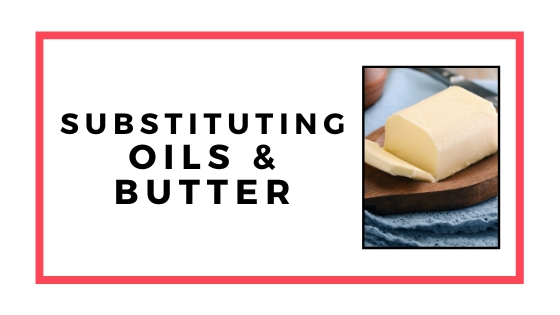
Substituting Oils/Butters:
- Vegetable oil (1 cup = ½ cup unsweetened applesauce or fruit puree OR 1 cup melted butter plus 1 more tablespoon of butter OR 1 cup coconut oil OR 1 ½ cup mayonnaise)
- Vegetable shortening (1 cup = 1 cup butter OR 1 cup coconut oil)
- Salted butter (1 cup = 1 cup shortening plus ½ teaspoon salt or ¾ cup vegetable oil plus ½ teaspoon salt OR ½ cup unsweetened applesauce plus ½ teaspoon salt OR 1 cup coconut oil)
- Unsalted butter (1 cup = 1 cup shortening or ¾ cup vegetable oil OR ½ cup unsweetened applesauce OR 1 cup coconut oil)
For more information on the differences between salted and unsalted butter, see this post: Salted Butter vs Unsalted Butter (Best butter for baking cakes)
And below is the printable substitution list.
Just click on the graphic below or the button below that and it will automatically download. You can then save it to your phone, computer or print it out for reference later.
For all the cake baking tips on the blog, click here: Cake Baking Tips
Don’t forget to pin it below!

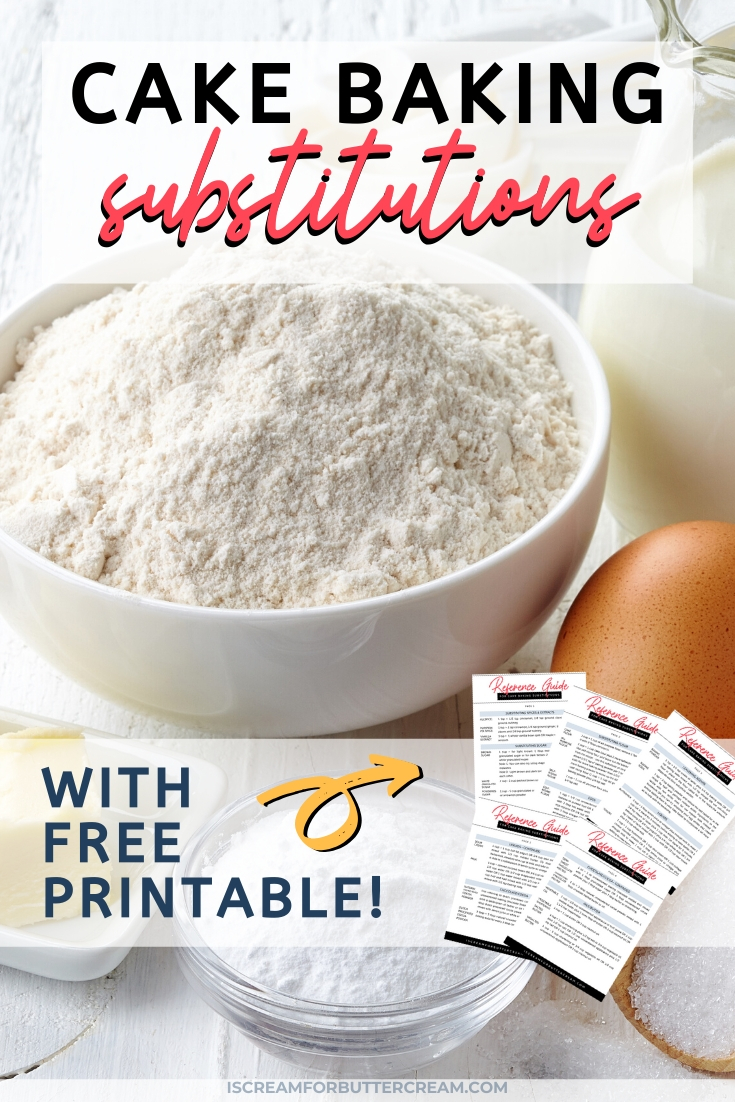
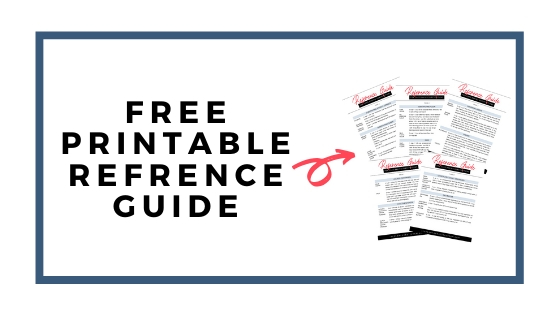
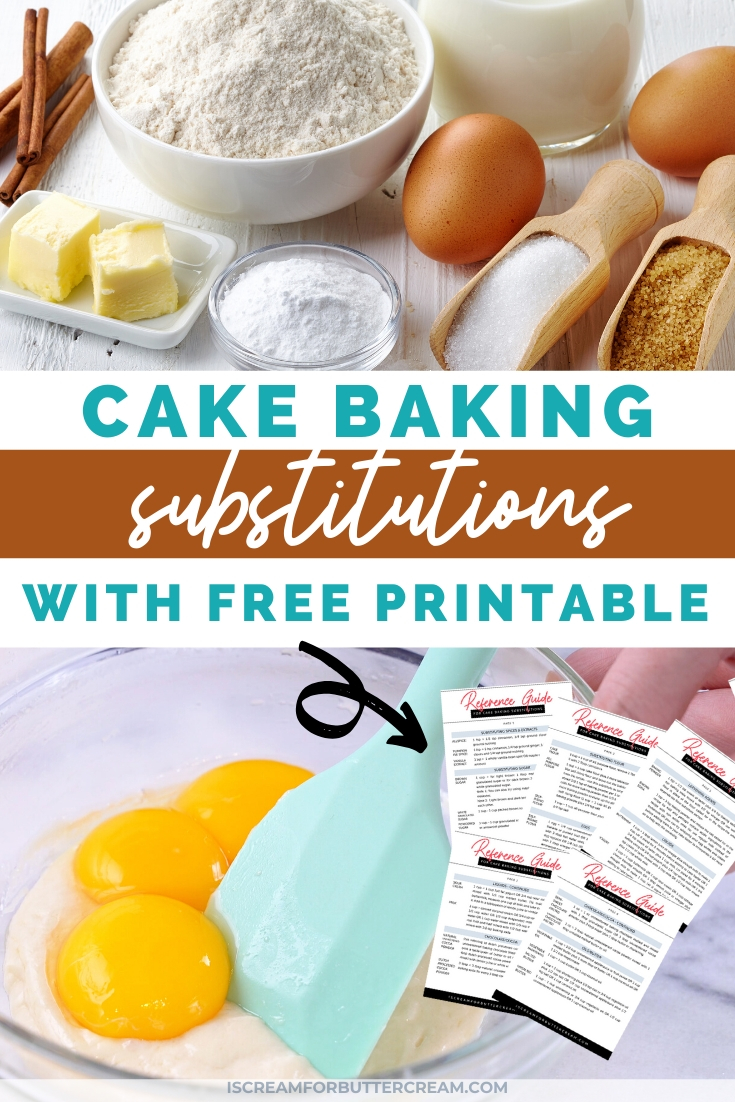
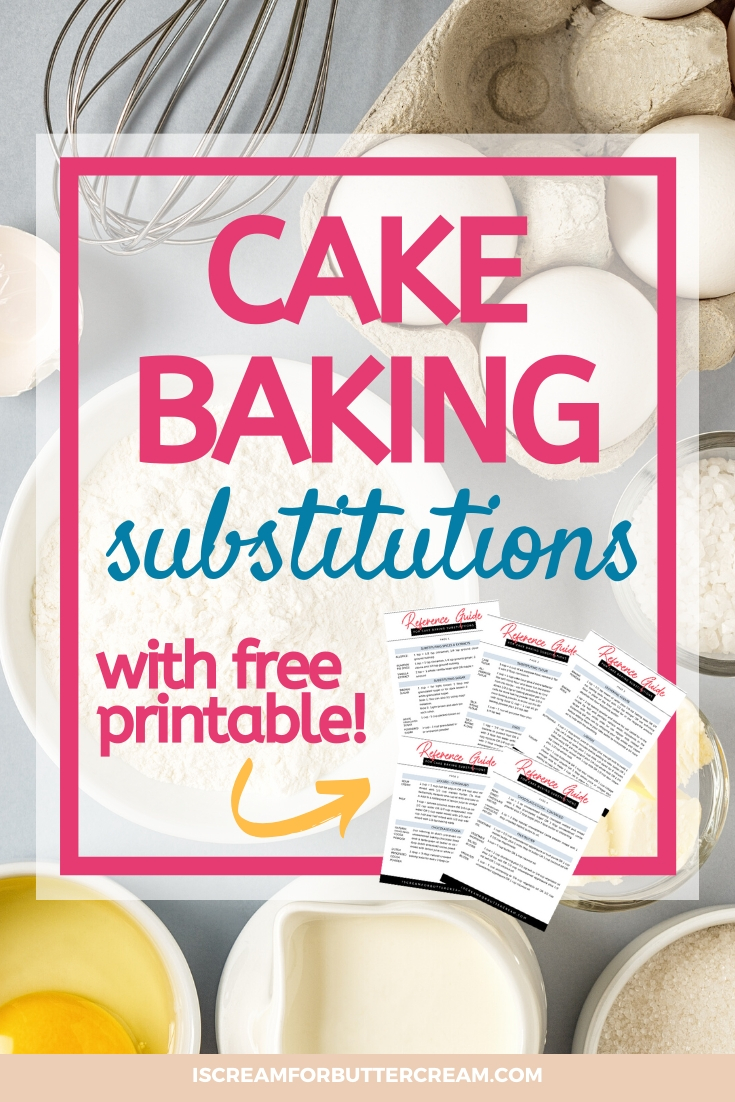
Babz Carroll
I want to make a yellow box cake mix using low fat cream cheese, frozen blueberries and lemon crème to make a lemon- blueberry bundt cake. How do I do this, what proportions of each do I use and do I prepare the box cake mix the original way listed on box instructions? I know this is a lot to ask, I couldn’t figure it out. Hope you can help.
Kara Jane
Hi Babz, I’m happy to try and help. I do have a recipe on the blog for a cream cheese ‘pound’ cake that uses a mix plus cream cheese. You might take a look at that and just sub with the cake mix flavor you want and the low fat cream cheese. (I’ll link to that below.) You can stir in the blueberries, but just know they may sink to the bottom of the pan before it finishes baking. Sometimes I actually add them in after I’ve already poured the batter into the pan, then just loosely mix them in before I bake it…that way they don’t sink all the way to the bottom.
As far as the lemon creme goes, do you mean like lemon curd? I’m not sure how it would work adding it into the cake batter. It might be something to have on the side as a sort of topper to the cake when you slice it. You could always add in a little lemon extract to the cake though to give it a little lemon flavor. Hope this helps.